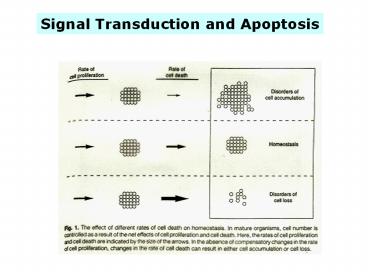Signal Transduction and Apoptosis - PowerPoint PPT Presentation
1 / 48
Title:
Signal Transduction and Apoptosis
Description:
Signal Transduction and Apoptosis The wider Bcl-2 family Functional role of CED-9/CED-4/CED-3 complexes Model of receptor-mediated caspase activation Intrinsic cell ... – PowerPoint PPT presentation
Number of Views:137
Avg rating:3.0/5.0
Title: Signal Transduction and Apoptosis
1
Signal Transduction and Apoptosis
2
The Nobel Prize for Physiology or Medicine 2002
Sydney Brenner, John Sulston, and Robert
Horvitz In a move that many will regard as long
overdue, the Nobel committee honoured Sydney
Brenner with the Nobel Prize for Physiology or
Medicine. John Sulston and Robert Horvitz will
share the prize that has been awarded in
recognition of the triumvirate's seminal studies
on the nematode worm Caenorhabditis elegans.
Their discoveries concerning genetic regulation
of organ development and programmed cell death
have given insights into these processes in many
other organisms.
3
The 2001 Nobel Prize in Physiology or Medicine 8
October 2001 The Nobel Assembly at Karolinska
Institutet has today decided to award The Nobel
Prize in Physiology or Medicine for 2001jointly
to Leland H. Hartwell, R. Timothy (Tim) Hunt and
Paul M. Nurse for their discoveries of "key
regulators of the cell cycle"
Summary All organisms consist of cells that
multiply through cell division. An adult human
being has approximately 100 000 billion cells,
all originating from a single cell, the
fertilized egg cell. In adults there is also an
enormous number of continuously dividing cells
replacing those dying. Before a cell can divide
it has to grow in size, duplicate its chromosomes
and separate the chromosomes for exact
distribution between the two daughter cells.
These different processes are coordinated in the
cell cycle. This year's Nobel Laureates in
Physiology or Medicine have made seminal
discoveries concerning the control of the cell
cycle. They have identified key molecules that
regulate the cell cycle in all eukaryotic
organisms, including yeasts, plants, animals and
human. These fundamental discoveries have a great
impact on all aspects of cell growth. Defects in
cell cycle control may lead to the type of
chromosome alterations seen in cancer cells. This
may in the long term open new possibilities for
cancer treatment.
4
???? ?????
5
Cell Death
6
(No Transcript)
7
Diseases associated with dysregulation of
apoptosis
Thompson CB. Science 267, 1456-1462 (1995)
8
Agents reported to induce or inhibit apoptosis
9
Hoechst 33258 stain of HeLa cells
Starosporine
Control
EM (Left condensed chromatin) (Right
cytoplasmic blebbing)
10
Methods for DNA fragmentation analysis
TUNEL assay
Gel electrophoresis
C ST
Terminal dUTP Nucleotide Labeling
assay fluorecein-labeled deoxynucleotide/ termina
l deoxynucleotidyl transferase enzyme
(Staurosporine-treated A431 cells, 10 mM, 6 hr)
11
Phosphatidylserine (PS) externalization
Annexin V-FITC/PI stain
PDT
(Staurosporine-treated A431 cells , 10 mM, 6 hr )
(PDT-treated A431 cells , 2 hr )
12
Caenorhabditis elegans
13
Life cycle of Caenorhabditis elegans
14
Identification of the genes involved in
developmental apoptosis in C. elegans
15
Cell 75, 641-652, Nov. 19, 1993 The C. elegans
Cell Death Gene ced-3 Encodes a Protein Similar
to Mammalian Interleukin-1b-Converting Enzyme
Yuan J, Shaham S, Ledoux S, Ellis HM, Horvitz
HR.Program of Neurosciences, Harvard Medical
School, Boston, Massachusetts 02115.
We have cloned the C. elegans cell death gene
ced-3. A ced-3 transcript is most abundant during
embryogenesis, the stage during which most
programmed cell deaths occur. The predicted CED-3
protein shows similarity to human and murine
interleukin-1 beta-converting enzyme and to the
product of the mouse nedd-2 gene, which is
expressed in the embryonic brain. The sequences
of 12 ced-3 mutations as well as the sequences of
ced-3 genes from two related nematode species
identify sites of potential functional
importance. We propose that the CED-3 protein
acts as a cysteine protease in the initiation of
programmed cell death in C. elegans and that
cysteine proteases also function in programmed
cell death in mammals.
16
Interleukin-1b-Converting Enzyme (ICE)
17
Nature 356, 768-774 (1992) A novel heterodimeric
cysteine protease is required for Interleukin-1b
processing in monocytes
18
THP-1 cells, the human monocytic leukemia cell
line
19
Organization of the human ICE cDNA
20
Substrate specificity of the human ICE cDNA
21
(No Transcript)
22
Comparison of structural features of the CED-3
protein and human ICE
23
Nature 371, Sep. 22 (1994)
24
Nature 376, 37-43 (1995) Identification and
inhibition of the ICE/CED-3 protease necessary
for mammalian apoptosis
Biotin-DEVD-CHO
25
(No Transcript)
26
TIBS 22, 299-306 (1997)
caspase
cysteine
aspartic acid
27
Specificities and proposed biological functions
for caspases
28
Proteolytic substrates for caspases during
apoptosis
29
?
30
Cell 86, 147-157, (1996) Induction of Apoptotic
Program in Cell-Free Extracts Requirement for
dATP and Cytochrome C
31
Cell 90, 405-413, (1997) Apaf-1, a Human Protein
Homologous to C. elegans CED-4, Participates in
Cytochrome c-Dependent Activation of Caspase-3
32
Model of caspase-3 activation through mitochondria
33
(No Transcript)
34
The wider Bcl-2 family
35
Functional role of CED-9/CED-4/CED-3 complexes
36
(No Transcript)
37
(No Transcript)
38
(No Transcript)
39
(No Transcript)
40
Model of receptor-mediated caspase activation
41
(No Transcript)
42
(No Transcript)
43
Intrinsic cell death signaling
Progress in Neuro-Psychopharmacology Biological
Psychiatry 27 (2003) 199 214
44
Extrinsic cell death signaling
Progress in Neuro-Psychopharmacology Biological
Psychiatry 27 (2003) 199 214
45
(No Transcript)
46
TIBS 22, 299-306 (1997)
47
(No Transcript)
48
Model of caspase-3 activation through mitochondria




















![[VII]. Regulation of Gene Expression Via Signal Transduction PowerPoint PPT Presentation](https://s3.amazonaws.com/images.powershow.com/4917995.th0.jpg?_=20131220041)










